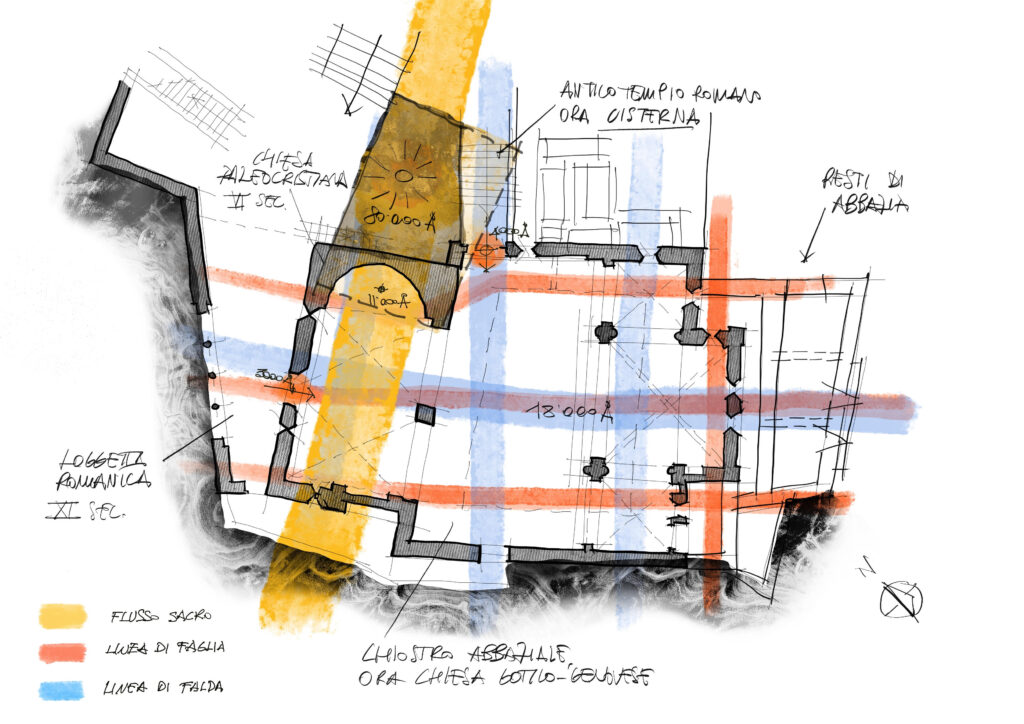As a sculpture seems to spring from natural stone, so the church of San Pietro in Porto Venere, in La Spezia’s province, emerges from the cliff, as if the rock, ascending, had given itself a geometric order.
We reach the building by following a walkway that runs alongside the marina, climbing up to the extreme tip of the cliff.

At the top of the staircase, the entrance leads us to a room, with an almost square plan, divided into aisles. Two polystyle pillars leads in a short transept with three square spaces of which the altar, in the center of greater width, surmounted by pointed cross vaults that reflect the characteristic two-color of the Genoese.
The composition recalls the Benedictine buildings and derives its shape from having occupied the pre-existing abbey’s cloister.
A previous early Christian church, now used as a narthex, open on one side to be merged. It looks like a space with a single nave marked by a double cross-vaulted roof with a side entrance and a semicircular apse basin. This entrance, which is now aligned with the main altar, leads in a Romanesque loggia overlooking the secondary sea.
Although heterogeneous, the result of successive mergers is organic and with numerous references to previous styles and wise respect for the genius loci.

A keystone at the underground church entrance (currently not accessible to the public) depicts a ‘flower of life’ and a small rose window placed on the bell tower, a Templar cross. That indicates that we are in the presence of wisdom tradition builders who were well aware of the energies involved.
We seek now the invisible architecture that supports the stone building. We meet at the main EAST entrance the typical geopathy point that leads us to a vibrational fall at 4,000 Å, while in the entrance aligned with the altar, to the NORTH, we read 3,000 Å: Access to a sacred space is signaled in the unconscious of anyone who crosses its threshold.

The interior of the church gives off a vibration of 18,000 Å, generously in the Sacred Field.
A fault line and a water line are overlapping on the major axis. The two minor nacelles are crossed by two fault lines that correspond exactly to the perimeter walls of the old abbey that can be read in the external walls of the church. The thin apse is identified by a fault line. Transept, side entrances and narthex are crossed by aquifer lines: probably freshwater veins that flow into the sea from the underlying rocks.
The analysis seems to have ended when we identify a reading of 11,000 Å at the altar of the early Christian church, in the hemicycle now occupied by a statue of St. Peter.
We sharpen the search and find a line of Sacred Flow, currently unidentified, which runs along the early Christian church axis. We circumnavigate the church from the outside to better define the Sacred Flow trend and we notice an inconsistency between the external and internal space: an inaccessible room walled up on all sides leaning against the early Christian church hemicycle. We consult plans and reliefs and we find that this space is identified first as a ‘cistern’ and then as the ‘ancient Roman temple site’. For an accurate reading we are forced to climb the ‘cistern’ roof where we can make a direct survey. Here, in the very center, we find an 80,000 Å emanation, exactly where the ancient Roman temple is located.
Conclusions: Here, more than anywhere else, the alternation of power systems that take control of spaces endowed with religious phenomena of tellurism is evident. The same Roman civilization built the temple, probably dedicated to Venus Ericina, at the exact apex of the emanation, perhaps occupying megalithic sites of previous civilizations and cultures. We can observe the usual dissimulation of Christianity which sets up the cultic apparatuses on the periphery of the points of maximum emanation, diverting attention elsewhere on emanations of a lower order. In this specific case, the early Christian church maintained the eastward orientation of the Roman temple and developed along the line of the Sacred Flow, but placed the altar on the point of energy drop at 11,000 Å (probably the entrance to the Roman temple) . Of course, in setting up a cistern right in the energetic peak, the intent may have been to energize the stored water, with healing purposes for the monks and the faithful. However, the fact remains that this site is the fact that it is currently unaffordable, leaving important visitors only the ‘crumbs’ of this all-important Sacred Flow. Given the site importance and the discovery, we reserve further investigations, by accessing the underground church and the appurtenances of the old abbey plant.



